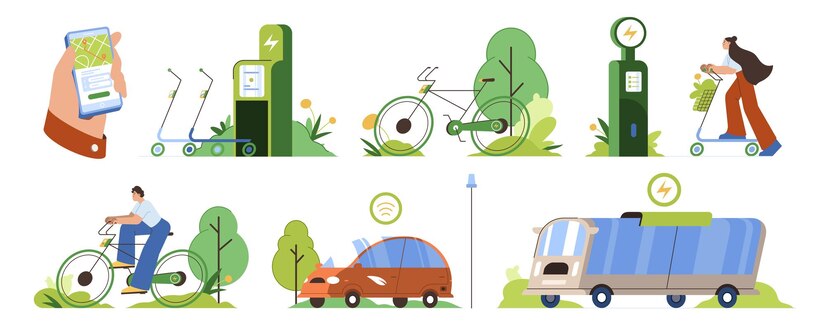Sustainable Transport Innovations: Enhancing Efficiency and Reducing Environmental Impact
By Marie Nieves
Since the dawn of mankind, transportation has been at the very core of our civilization. The invention of the wheel allowed us to cover greater distances, Roman roads, and the Silk Road made a bridge between Europe and Asia bridged the gap between Europe and Asia, and the Age of Exploration finally brought our world together. All great milestones in human history were marked by our ability to travel farther and more efficiently.
Now, in the age of sustainability, when there is little left to explore, the issue of efficiency is gaining an ever-increasing relevance, and it is only a matter of time before transportation gets under this green spotlight.
Well, let’s take a look at some of the latest sustainable transport innovations and see where the new, exciting milestones are that we need to pass.
The constant evolution of rail transport
Rail transport has always been one of the most popular, affordable, and efficient means of commuting. However, trains were not always among the fastest ways of getting from point A to point B, especially in countries like the USA, where coast-to-coast travel can last up to 62 hours.
Well, the tides are turning around, and they are turning fast. For instance, the Chinese Shanghai maglev train can now reach 268 mph (431 km/h), an excellent alternative to shorter and more expensive interstate flights. Speeding from coast to coast in hours is no longer a far-fetched future.
The rise of light-duty vehicles
On-road vehicles are among the greatest contributors to global transportation’s carbon footprint. Electric vehicles could solve this problem, but their mainstream penetration is still too slow to make a tangible difference. Well, if we can’t solve the issue immediately, that doesn’t mean we can’t mitigate it in the meantime.
Over the last few years, traditional petrol-fueled cars have started using ultra-efficient hydrogen, biofuels, and hybrid engines. If you are looking for sustainable transportation right now, your attention should be on these immediate resources.
Rise of on-demand services
Car ownership can prove challenging for a number of reasons. Buying your vehicle, the cost of ownership, maintenance, and adding to the carbon footprint with yet another vehicle are very hefty prices for a resource that, if you take a moment to think about it, sits parked 95% of the time.
So, it’s really not that hard to gain the popularity of brands like DPV Transportation, which handle the issue of transportation through rentals, shuttle services, and hired drivers. This lean model will only gain more popularity in crowded cities where finding a parking space can be challenging.
Public, shared, and non-motorized transport
All these things were once considered hacks and intelligent ways of getting around the vast, overly populated cities. But, all these small methods of getting around have proven their worth and are now growing into small business ventures, sponsored efforts, and other more traditional assets.
Bike rentals, carpooling, and business incentives for using public transport are gradually reducing the carbon demand in transportation. With roaming the cities becoming fast, practical, and cheap, the need to jam the traffic with personal vehicles is, as time goes by, becoming more trouble than worth.
Improvements in aviation and maritime transportation
In the globalized world, aviation and maritime transportation are essential for keeping our society alive and well. However, each of these two transport options is responsible for about 3% of global carbon emissions, which is a number that is not easy to neglect.
The good news is that patches for this issue are in the works. Some estimates say that, by 2050, fuel needs for these two means of transport should be 87% to 100% zero-emission. Pilot projects to determine the viability of the new types of fuel are already in motion, and we are eager to see the results.
Transition to smart cities
Last but not least, we would like to point out that all the efficient resources in the world, and individual assets will provide compromised results if all the moving parts are not moving in unison. That brings us to technologies like IoT and ML, which make ordinary devices capable of harnessing data from their environment, communicating with each other, and adjusting their performance accordingly.
This tech significantly impacted “smart homes”, massively improving their efficiency. Now, it’s time to translate these ideas to whole communities and their transportation infrastructure, hoping for the same results.
Conclusion
Well, there you have it – the top six ideas, technologies, and concepts that should overhaul the world of transportation and set it on a new, exciting course. Modern society is built on the ideas of sustainability and efficiency. Transportation, as one of its vital components, needs to follow in the same footsteps.
And, as we can see, we are ready for the next big leap in this regard. Being able to travel while producing zero carbon emissions is no longer a novel sci-fi idea. It’s only a matter of ‘when’,
Author bio: Marie Nieves is a passionate blogger with an eye for design, a flair for storytelling, and a love for culture. She contributes regularly to various blogs and online magazines, all while satisfying her wanderlust by exploring states and countries near and far.
